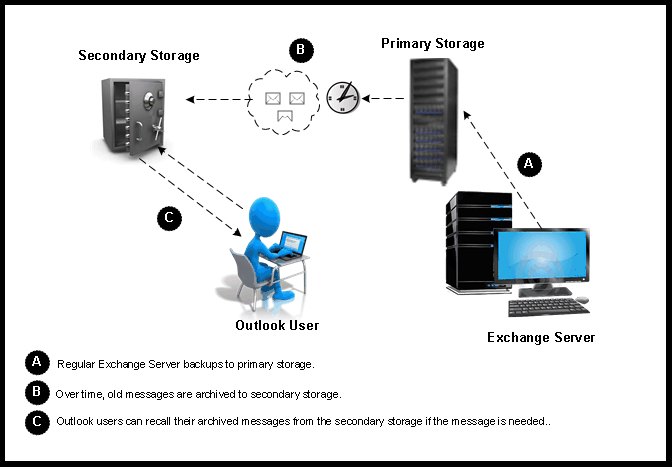 The Exchange Archiver Agents offer
the following key features:
The Exchange Archiver Agents offer
the following key features:
Table of Contents |
Where to go Next |
|
Walks you through the process of installing the Exchange Agents. |
The Exchange Archiver Agents provide a seamless vehicle for moving old or infrequently used mailbox items to secondary storage. In doing so, regular backups of more vital Exchange data are more efficient, costs are saved by freeing up primary disk space, and end-user mailboxes become easier to manage. Added options for Outlook integration, compliance searches, and reporting help ensure all archived Exchange data is easily traceable and retrievable whenever the need arises.
 The Exchange Archiver Agents offer
the following key features:
The Exchange Archiver Agents offer
the following key features:
The Exchange Mailbox and Public Folder Archiver Agents seamlessly move messages meeting specified criteria to secondary storage. Optionally, archived messages can be replaced with special header icons in the original mailbox, known as stubs, which contain information for recovery. Users can double-click the message stub in Outlook or Outlook Web Access (OWA) to recover the original message. Alternatively, users can also ask the administrator to browse the CommCell Console to recover the message.
Exchange Compliance Archiver works in conjunction with the message journaling feature of Microsoft Exchange Server software to archive all incoming and outgoing messages and attachments. All incoming messages and outgoing messages are captured in the Exchange Journal Mailbox, which is then archived with the Exchange Compliance Archiver agent according the schedules you set. Incoming messages are written to the journal as they come into the Exchange Server. Therefore, all messages are recorded, regardless of whether the message recipient deletes the message in his or her mailbox.
The archived data remains available for retrieval for the length of time set by the retention rules. During this period the data is readily available for access and retrieval by authorized users. They can retrieve duplicate copies from the archive, which remains under the management of the Storage Policy. All archived data is protected from any edit or alteration from all users within the context of the archival system (i.e., the archived data on the storage media cannot be written to or altered).
 Outlook Add-In fully integrates with Microsoft Outlook to provide users with
a convenient way to browse, search and recover mailbox items directly from
Outlook. All mailbox entities, including messages, attachments, calendar items,
and notes, are retrievable from either the locally installed Outlook application
or the Outlook Web Access web browser application.
Outlook Add-In fully integrates with Microsoft Outlook to provide users with
a convenient way to browse, search and recover mailbox items directly from
Outlook. All mailbox entities, including messages, attachments, calendar items,
and notes, are retrievable from either the locally installed Outlook application
or the Outlook Web Access web browser application.
Desktop Browse enables users to browse and restore data from a Web Browser, which provides the facility to access and restore data from anywhere.
Content Indexing and Search enables users to content index their data and later search the data from a user-friendly web interface. The users can also perform restore operations or other advanced actions on the searched data.
The Microsoft Exchange Server iDataAgent documentation uses the following terminology:
Database |
Includes all operational elements of the Exchange Server, such as Stores, Transaction Logs, Patch Files, and Exchange Organizational Data. |
Non-Exchange Server |
A computer other than the Exchange Server on which the Mailbox and Public Folder iDataAgents may be installed. Using a non-Exchange Server often results in less overhead on the Exchange Server during backup and restore operations. |
Affinity |
An association between two entities used in Automatic Discovery scenarios. For example, automatic discovery of mailboxes by database affinity implies the mailbox is included in the selected database. |